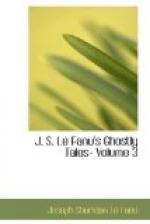During the years, now seven, that had elapsed since the marriage of Sir Bale and Miss Janet Feltram, there had happened but one event, except the death of their only child, to place them in mourning. That was the decease of Sir William Walsingham, the husband of Lady Mardykes’ sister. She now lived in a handsome old dower-house at Islington, and being wealthy, made now and then an excursion to Mardykes Hall, in which she was sometimes accompanied by her sister Lady Haworth. Sir Oliver being a Parliament-man was much in London and deep in politics and intrigue, and subject, as convivial rogues are, to occasional hard hits from gout.
But change and separation had made no alteration in these ladies’ mutual affections, and no three sisters were ever more attached.
Was Lady Mardykes happy with her lord? A woman so gentle and loving as she, is a happy wife with any husband who is not an absolute brute. There must have been, I suppose, some good about Sir Bale. His wife was certainly deeply attached to him. She admired his wisdom, and feared his inflexible will, and altogether made of him a domestic idol. To acquire this enviable position, I suspect there must be something not essentially disagreeable about a man. At all events, what her neighbours good-naturedly termed her infatuation continued, and indeed rather improved by time.
CHAPTER XXIV
An Old Portrait
Sir Bale—whom some remembered a gay and convivial man, not to say a profligate one—had grown to be a very gloomy man indeed. There was something weighing upon his mind; and I daresay some of the good gossips of Golden Friars, had there been any materials for such a case, would have believed that Sir Bale had murdered Philip Feltram, and was now the victim of the worm and fire of remorse.
The gloom of the master of the house made his very servants gloomy, and the house itself looked sombre, as if it had been startled with strange and dismal sights.
Lady Mardykes was something of an artist. She had lighted lately, in an out-of-the-way room, upon a dozen or more old portraits. Several of these were full-lengths; and she was—with the help of her maid, both in long aprons, amid sponges and basins, soft handkerchiefs and varnish-pots and brushes—busy in removing the dust and smoke-stains, and in laying-on the varnish, which brought out the colouring, and made the transparent shadows yield up their long-buried treasures of finished detail.
Against the wall stood a full-length portrait as Sir Bale entered the room; having for a wonder, a word to say to his wife.
“O,” said the pretty lady, turning to him in her apron, and with her brush in her hand, “we are in such in pickle, Munnings and I have been cleaning these old pictures. Mrs. Julaper says they are the pictures that came from Cloostedd Hall long ago. They were buried in dust in the dark room in the clock-tower. Here is such a characteristic one. It has a long powdered wig—George the First or Second, I don’t know which—and such a combination of colours, and such a face. It seems starting out of the canvas, and all but speaks. Do look; that is, I mean, Bale, if you can spare time.”




